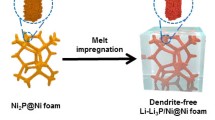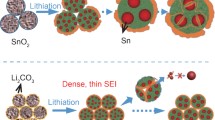Abstract
Lithium metal anode is one of the ideal anodes with high energy density. However, the problems of lithium dendrite growth and infinite volume expansion lead to safety and cycling stability problems in lithium metal anode batteries, which became the biggest obstacle to the commercial application of lithium metal anodes. This paper reports a three-dimensional nanostructured TiO2 flexible lithium metal anode scaffold loaded with Sn. Three-dimensional nanostructured TiO2 has a high specific surface area that can accommodate lithium deposition with high capacity while suppressing lithium dendrite growth. At a current density of 1 mA cm−2 and a deposition volume of 5 mAh cm−2, the 35th circulate coulomb efficiency of the lithium metal anode scaffold is still 98%. The nano-Sn metal with better pro-lithium properties loaded on the lithium metal anode scaffold composed of TiO2 skeleton, which can sufficiently reduce the nucleation potential barrier of Li+ and enable the uniform deposition of lithium on the support, assembled into a full coin cell using a LiFeO4 (LFP)-based positive electrode exhibit high-capacity retention and high energy density (443 Wh kg−1) after 200 cycles at 1C (= 170 mA g−1).







Similar content being viewed by others
Data Availability
The data that support the findings of this study are available from the corresponding authors.
References
Mu T, Lu H, Ren Y (2022) Interface defect chemistry enables dendrite-free lithium metal anodes. Chem Eng J 437:135109
Han Y, Liu B, Xiao Z (2021) Interface issues of lithium metal anode for high-energy batteries: challenges, strategies, and perspectives. InfoMat 3:155–174
Zhang R, Shen X, Zhang YT (2022) Dead lithium formation in lithium metal batteries: a phase field model. J Energy Chem 71:29–35
Cao W, Li Q, Yu X (2022) Controlling Li deposition below the interface. eScience 2:47–78
Chen XR, Yan C, Ding JF (2021) New insights into “dead lithium” during stripping in lithium metal batteries. J Energy Chem 62:289–294
Xu W, Wang J, Ding F (2014) Lithium metal anodes for rechargeable batteries. Energy Environ Sci 7:513–537
He Y, Ren X, Xu Y (2019) Origin of lithium whisker formation and growth under stress. Nat Nanotechnol 14:1042–1047
Lu Y, Lu Y, Jin C (2021) Natural wood structure inspires practical lithium–metal batteries. ACS Energy Lett 6:2103–2110
Jiang Z, Jin L, Han Z (2019) Facile generation of polymer–alloy hybrid layers for dendrite-free lithium-metal anodes with improved moisture stability. Angew Chem Int Ed 58(33):11374–11378
Zhang Z, Huang Y, Li C (2021) Metal–organic framework-supported poly(ethylene oxide) composite gel polymer electrolytes for high-performance lithium/sodium metal batteries. ACS Appl Mater Interfaces 13:37262–37272
Chang S, Jin X, He Q (2022) In situ formation of polycyclic aromatic hydrocarbons as an artificial hybrid layer for lithium metal anodes. Nano Lett 22:263–270
Yang CP, Yin YX, Zhang SF (2015) Accommodating lithium into 3D current collectors with a submicron skeleton towards long-life lithium metal anodes. Nat Commun 6:8058
Ni C, Mao J, Cheng Z (2021) Si/ZnO framework: 3D lithiophilic structure for dendrite-free lithium metal batteries. J Alloys Compd 876:160188
Luo KL, Leng ZY, Li ZD (2022) Stable Li metal anode in a lithiophilic shuttle. Nanoscale 14:3935–3945
Zuo ZF, Zhuang LB, Xu JZ (2020) Lithiophilic silver coating on lithium metal surface for inhibiting lithium dendrites. Front Chem 8:109
Yan J, Ye M, Zhang Y (2022) Graphene enabled electric-field regulation and ionic redistribution around lithiophilic aurum nanoparticles toward a dendrite-free and 2000-cycle-life lithium metal battery. Chem Eur J 28:e202201151
Wang CH, Deng T, Fan XL (2022) Identifying soft breakdown in all-solid-state lithium battery. Joule 6(8):1770–1781
Mancini M, Kubiak P, Wohlahrt-mehrens M (2010) Mesoporous anatase TiO2 electrodes modified by metal deposition: electrochemical characterization and high rate performances. J Electrochem Soc 157:A164–A170
K, Hemalatha, AS, Prakash, K, Guruprakash, M, Jayakumar (2010) TiO2 coated carbon nanotubes for electrochemical energy storage. J Mater Chem A 26:1757–1766
Kim HS, Yu SH, Cho YH (2014) TiO2-core/Sn-shell nanotube arrays based on monolithic negative electrode for Li-ion batteries. Electrochim Acta 130:600–605
Knvan L, Kalbac M, Zukalova M (2004) Lithium storage in nanostructured TiO2 made by hydrothermal growth. Chem Mater 16:477–485
Bresser D, Paillard E, Binetti E (2012) Percolating networks of TiO2 nanorods and carbon for high power lithium insertion electrodes. J Power Sources 206:301–309
Brumbariv J, Vivek JP, Leonardi S (2015) Correction: oxygen deficient, carbon coated self-organized TiO2 nanotubes as anode material for Li-ion intercalation. J Mater Chem A 3:24569
Wu Q, Xu J, Yang X (2015) Ultrathin anatase TiO2 nanosheets embedded with TiO2-B nanodomains for lithium-ion storage: capacity enhancement by phase boundaries. Adv Energy Mater 5:1401756
Wei L, Deng N, Ju J (2022) A review on nanofiber materials for lithium-metal batteries to suppress the dendritic lithium growth. Chem Eng J 433:134392
Fang S, Shen L, Hoefling A (2021) A mismatch electrical conductivity skeleton enables dendrite–free and high stability lithium metal anode. Nano Energy 89:106421
Wang M, Tan Q, Liu L (2019) Efficient separation of aluminum foil and cathode materials from spent lithium-ion batteries using a low-temperature molten salt. ACS Sustain Chem Eng 7:8287–8294
Yi J, Chen J, Yang Z (2019) Facile patterning of laser-induced graphene with tailored Li nucleation kinetics for stable lithium-metal batteries. Adv Energy Mater 9:1901796
Chen L, Fan X, Ji X (2019) High-energy Li metal battery with lithiated host. Joule 3:732–744
Cheng XB, Zhang R, Zhao CZ (2017) Toward safe lithium metal anode in rechargeable batteries: a review. Chem Rev 117:10403–10473
Zhang Z, Luo H, Liu Z (2022) A chemical lithiation induced Li4.4Sn lithiophilic layer for anode-free lithium metal batteries. J Mater Chem A 10:9670–9679
Zhao Y, Yang X, Sun Q (2018) Dendrite-free and minimum volume change Li metal anode achieved by three-dimensional artificial interlayers. Energy Stor Mater 15:415–421
Yun XY, Wang WW, Wang QC (2018) CoO nanofiber decorated nickel foams as lithium dendrite suppressing host skeletons for high energy lithium metal batteries. Energy Stor Mater 14:335–344
Wang Y, Zheng H, Hong L (2022) Lithium difluoro(bisoxalato) phosphate-based multi-salt low concentration electrolytes for wide-temperature lithium metal batteries: experiments and theoretical calculations. Chem Eng J 445:136802
Ding F, Xu W, Graff GL (2013) Dendrite-free lithium deposition via self-healing electrostatic shield mechanism. J Am Chem Soc 135:4450–4456
Zhou SY, Chen WX (2022) Efficient diffusion of superdense lithium via atomic channels for dendrite-free lithium-metal batteries. Energy Environ Sci 15:196–205
Chen T, Jian S, Xing J (2021) Self-formed lithiophilic alloy buffer layer on copper foam framework for advanced lithium metal anodes. ACS Appl Energy Mater 4:4879–4886
Huang MS, Yao ZG, Yang QF, Li CL (2021) Consecutive nucleation and confinement modulation towards Li plating in seeded capsules for durable Li-metal batteries. Angew Chem Int Ed 60:14040–14050
Yang QF, Cui MN, Hu JL, Chu FL, Zheng YJ, Liu JJ, Li CL (2020) Ultrathin defective C-N coating to enable nanostructured Li plating for Li metal batteries. ACS Nano 14:1866–1878
Wu CL, Hu JL, Yang QF, Lei M, Yu YF, Li CL (2023) Open framework perovskite derivate SEI with fluorinated heterogeneous nanodomains for practical Li-metal pouch cells. Nano Energy 113:2211–2855
Funding
This work was supported by Yunnan Major Scientific and Technological Projects (grant no. 202202AG050003); the Natural Science Foundation of Yunnan Province (grant no. 202101AW070006); the Yunnan Fundamental Research Projects (grant no. 202101BE070001-018, 202201AT070070).
Author information
Authors and Affiliations
Contributions
Bingnan Deng: conceptualization and writing—original draft. Rongwei Huang: writing—review and editing. Dan You: writing—review and editing. Wenhao Yang: writing—review and editing. Jiyue Hou: conceptualization and writing—review. Ao Li: conceptualization and writing—review. Dong Yang: conceptualization and writing—review. Fei Wang: conceptualization and writing—review. Xue Li: writing—review and editing and funding acquisition. Yiyong Zhang: writing—review and editing and funding acquisition.
Corresponding authors
Ethics declarations
Ethical approval
Not applicable.
Competing interests
The authors declare no competing interests.
Additional information
Publisher's Note
Springer Nature remains neutral with regard to jurisdictional claims in published maps and institutional affiliations.
Rights and permissions
Springer Nature or its licensor (e.g. a society or other partner) holds exclusive rights to this article under a publishing agreement with the author(s) or other rightsholder(s); author self-archiving of the accepted manuscript version of this article is solely governed by the terms of such publishing agreement and applicable law.
About this article
Cite this article
Deng, B., Huang, R., You, D. et al. The chemically deposited Sn combines with the TiO2 3D reticular structure to form a stable and uniform lithium metal anode. Ionics (2024). https://doi.org/10.1007/s11581-024-05474-9
Received:
Revised:
Accepted:
Published:
DOI: https://doi.org/10.1007/s11581-024-05474-9




